Banana Pi BPI-M5 Pro, also known as Armsom Sige5, is a low-profile single board computer (SBC) powered by the Rockchip RK3576 octa-core Cortex-A72/A53 SoC for the AIoT market that offers a mid-range offering between Rockchip RK3588 and RK3399 SoCs.
The board comes with 16GB LPDDR4X and 128GB eMMC flash by default, offers dual GbE, WiFi 6 and Bluetooth 5.2 connectivity, an M.2 2280 PCIe socket for expansion, HDMI and MIPI DSI display interfaces, two MIPI CSI camera interfaces, a few USB ports, and a 40-pin GPIO header.
Banana Pi BPI-M5 Pro specifications:
- SoC – Rockchip RK3576
- CPU
- 4x Cortex-A72 cores @ 2.2GHz, four Cortex-A53 cores @ 1.8GHz
- Arm Cortex-M0 MCU at 400MHz
- GPU – ARM Mali-G52 MC3 GPU with support for OpenGL ES 1.1, 2.0, and 3.2, OpenCL up to 2.0, and Vulkan 1.1
- NPU – 6 TOPS (INT8) AI accelerator with support for INT4/INT8/INT16/BF16/TF32 mixed operations.
- VPU
- Video Decoder: H.264, H.265, VP9, AV1, and AVS2 up to 8K @ 30fps or 4K @ 120fps.
- Video Encoder: H.264 and H.265 up to 4K @ 60fps, (M)JPEG encoder/decoder up to 4K @ 60fps.
- CPU
- System Memory – 8GB or 16GB 32-bit LPDDR4x
- Storage
- 32GB or 128GB eMMC flash
- MicroSD card slot
- M.2 Key-M socket for M.2 2280 NVMe SSD (See Expansion section)
- Footprint for UFS storage, but apparently unused
- Video Output
- HDMI 2.0 port up to 4Kp120
- MIPI DSI connector up to 2Kp60
- DisplayPort 1.4 via USB-C up to 4Kp120
- Audio – Speaker header, digital audio output via HDMI
- Camera I/F – 2x 2-lane MIPI CSI connectors
- Networking
- 2x Gigabit Ethernet ports
- WiFi 6 and Bluetooth 5.2 via Realtek RTL8852BS
- USB – 1x USB 3.0 port, 1x USB 2.0 port, 1x USB Type-C port
- Expansion
- 40-pin GPIO header
- M.2 Key-M socket (PCIe 2.1 x1)
- Misc
- MaskROM button, Reset button, Power button
- Fan connector
- RTC battery connector
- 2x LED
- Power Supply – 4.5V to 23V via USB Type-C PD port
- Dimensions: 92 x 62mm (8-layer PCB)
- Weight – 43 grams
- Temperature Range – 0°C to 80°C
The Banana Pi BPi-MP5 Pro supports Android 14 and Debian 12 images, Buildroot is supported through official Rockchip support, and third-party Armbian Ubuntu and Debian images may become available soon. Documentation is available on both Banana Pi and ArmSom websites with the latter providing links to the Android 14 and Debian 12 images.
Banana Pi previously released the BPI-M5 SBC with an Amlogic S905X3 SoC, so you’d assume the Pro version would have many features in common, but the two boards have completely different designs…
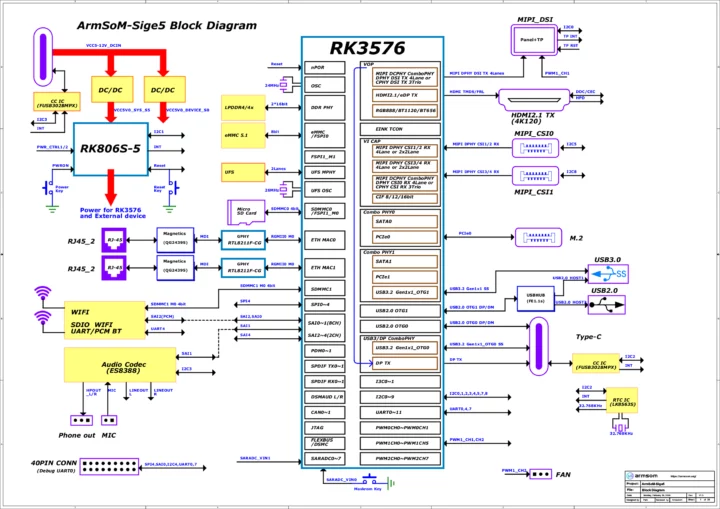
The Banana Pi BPI-M5 Pro is for sale on SinoVoIP’s Aliexpress store for $131.58 (8GB LPDDR4/64GB eMMC configuration) unless you also need an enclosure with antennas in which case the price is $146.31. Alternatively, the ArmSom Sige5 Pro is sold for $124 plus shipping on the company’s website. It does not seem particularly good value as the Orange Pi 5 Pro which similar features (but only one GbE port) and a more powerful Rockchip RK3588S processor goes for $96.99 on Amazon in the same 8GB RAM configuration and a 64GB eMMC flash module adds just $18.99. Maybe it is still worth it for use cases where the low-profile design may be important.
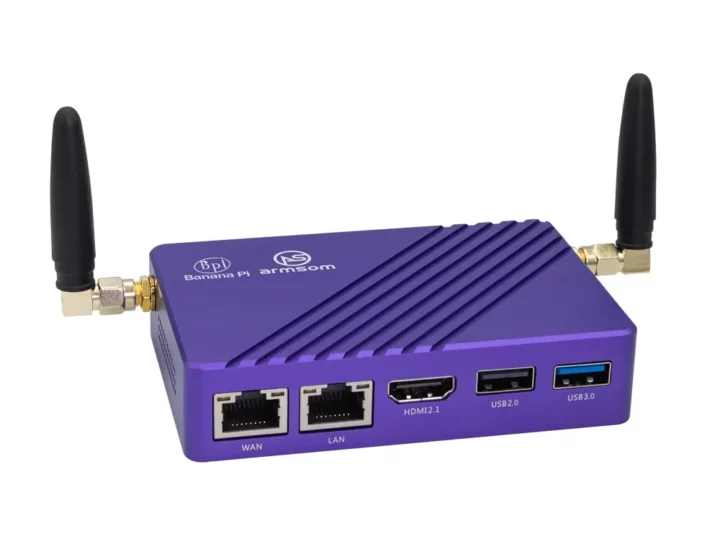
Updated: This post was initially published on May 2, 2024, and updated following availability on Aliexpress and the launch of the enclosure.

Jean-Luc started CNX Software in 2010 as a part-time endeavor, before quitting his job as a software engineering manager, and starting to write daily news, and reviews full time later in 2011.
Support CNX Software! Donate via cryptocurrencies, become a Patron on Patreon, or purchase goods on Amazon or Aliexpress. We also use affiliate links in articles to earn commissions if you make a purchase after clicking on those links.


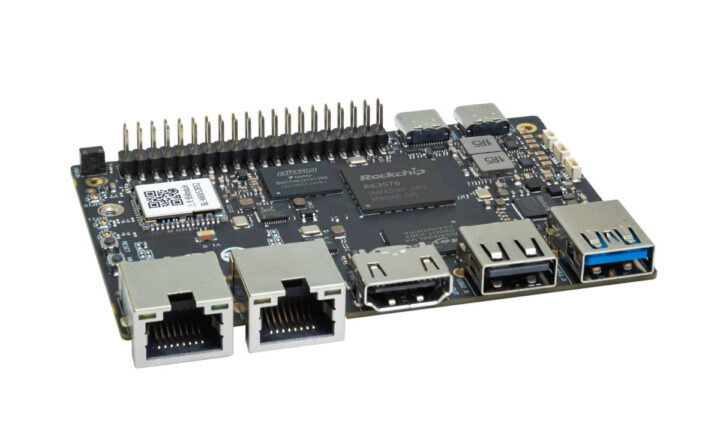
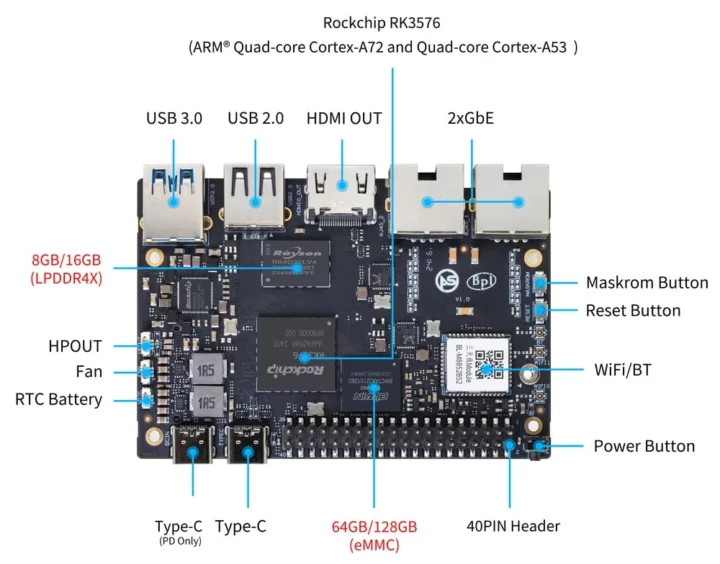
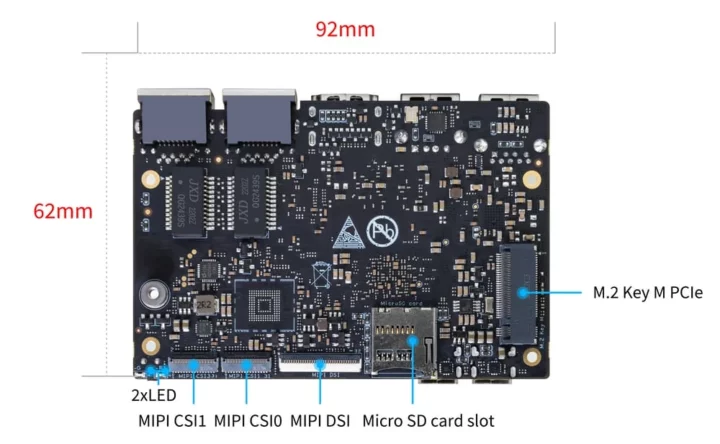


Looks good but I will never buy a not ripe banana. Sinovoip is just horrible with their Software part, even the own wiki is wrong in vast parts. They are just a joke – expect NO support at all.
They sell hardware and don’t care about software. Orangepi has even bigger trash and nobody seems to care.
Its the SoC manufacurer that should continue the support of the hardware. Like on GPU cards. You get the PCIe GPU card from for example Asus, but the drivers are never from Asus but from the ASIC manufacturer.
Here its Rockchip that should provide the software support.
The single thing you need is the typical for ARM based devices the hardware description file to boot your linux.
If you like automated updates, then add the board you like to the armbian build service.
I’ve just noticed the board design is more or less the same as the Banana Pi BPI-M7 with a Rockchip RK3588 SoC.
https://www.cnx-software.com/2024/01/30/banana-pi-bpi-m7-thin-rockchip-rk3588-sbc-dual-2-5gbe-m-2-nvme-storage-hdmi-2-1/
Same dimensions (Banana-ITX), most connectors placed identically but the mounting hole positions already differ: e.g. there’s a power button on the RK3576 based BPI-M11 Ultra compared to the RK3588 based BPI-M9 w/o Pro/Ultra/Max/Turbo/Ultimate:
https://i.postimg.cc/R03DJ08s/Unripe-bananas.jpg
@tkaiser
I am waiting for your bench results of the RK3576. Thanks for the great database i use regulary to compare the speed of different SoC.
> I am waiting for your bench results of the RK3576.
Then you better ask the Banana people to run sbc-bench and publish the results URL? But I think there’s nothing great to expect. It’s four old and boring A53 combined with four old and boring A72, both with slightly higher clockspeeds than usual.
If the memory controller can’t keep up with cpufreq I don’t see this thing excel with multi-threaded workloads (single-threaded it’s maybe 110%-120% of an RK3399/OP1 AKA dog slow by today’s standards)
I’m not seeing any value in this chip in the first place. It’s just what the RK3399 ought to have been 8 years ago when it was released, but now it’s too late. It’s still heavily missing I/Os for example. I don’t expect anyone to invest much time trying to get that totally outdated beast on par with modern designs. And it’s even more surprising that an SBC vendor adopted it!
You are completely missing the points of the RK3576. Its the most modern SoC that can run on 100% free Software. Its based on same 8nm like the RK3588.
The RK3399 was really slow and produced much heat because of the old manufacturing process. The Amlogic based Odroid N2 was much better then the RK3399 when using it daily as a computer. The RK3588 series sadly needs for a working GPU closed source software. If you dont need any GPU power but most possible CPU power, just take the RK3582. In general you can unlock the two disabled CPU cores on the RK3582 but the GPU is in most cases really broken but when you want to run free and opensource software you of course dont want use it either ways. On the RK3582 you still have 8k graphics output without GPU.
> In general you can unlock the two disabled CPU cores on the RK3582
But you may end up with one or even two of those disabled A76 still not being enabled due to having failed factory QA testing and marked as broken. And in that case not even Jianfeng’s u-boot patch will help.
> missing the points of the RK3576. Its the most modern SoC that can run on 100% free Software
Calling Cortex-A53 and A72 in 2024 ‘most modern’ is somewhat funny. And does ‘100% free software’ also include no need for BLOBs like BL31 and DRAM initialization?
@tkaiser
Is there any other 8nm or smaller manufactured SoC that can already run its GPU and hopefully everything else with fully free software?
Thanks for mentioning the raminit. I hope there are experienced people working on making this also free.
I would really like to see some more recent hardware with 8nm or less working just with free software. If you have some greater overview of what is currently available, i would be happy to read about it.
> Is there any … SoC that can already run its GPU and hopefully everything else with fully free software?
AFAIK the only ARM SoCs able to run a fully FOSS software stack are from Allwinner thanks to awesome linux-sunxi community. Mainlining efforts take usually until the hardware is obsolete and no idea which marketing BS wrt process node Allwinner is generating.
Alllooser is a terrible company. One of the worst from the free software community view. They have for example violated GPL and instead of fixing this violation, they tried to hide it better. Noone should use their products. They dont support or benefit the free software world. One of the best instead is for example NXP. They contribute and mainline often themself their SoC’s.
I am looking for a powerfull SoC that can run a daily linux desktop computer with no closed source parts.
> Alllooser… blablabla
I tried to explain which ARM SoCs may run with a fully open software stack (including those hidden processors that really control all the hardware) and you reply with Wikipedia nonsense tracing back to linux-sunxi wiki (that is the awesome community doing the reverse engineering and mainlining work for these SoCs)
> any other 8nm or smaller manufactured SoC
Is there a source for this 8nm claim? If it’s the same as with RK3588 then we’re most probably talking about Samsung’s 8LPP process which is an extension of their 10LPP process said to have a fin pitch of 42nm and a gate pitch of 64nm.
RK3576=8nm, here few sources.
https://zhuanlan.zhihu.com/p/685610235
https://pretech-e.com/cases_212/765.html
I am also expecting to be same production source like RK358*(there is now the RK3582 in same series). Thanks for the information its made by Samsung 8LPP
There have been also ‘sources’ in the past claiming RK3568 would be on a more advanced process node than RK3566 but both share same DVFS OPP: 825.0 mV @ 408 MHz and 1050.0 mV @ 1800 MHz. While the A55 in RK3588 use 675.0 mV at 408 MHz but also 1050.0 mV at 1800 MHz.
Let’s wait for the public appearance of rk3576.dtsi and stop spreading rumours for now.
I don’t think there is a way to really tell from the dtsi file, but there are two hints in the block diagram showing the same NPU as RK3588 and an LP-DDR5 memory controller, both would be strong hints that it uses the same process as well. The memory controllers tend to be built specifically for one process for the external I/O side I’m not aware of any 22nm (or even 12nm) SoC with LP-DDR5. The NPU is similar to the one in the 22nm RK356x, but is several times larger, which would justify going with a smaller process.
Well, all that will not turn an aging A72 into something suddenly great. It will still remain an old slow CPU core for todays software. A good hint usually to see that a CPU core is getting old is that RPi adopts it. And here, it’s the code of the previous generation of RPi, that says a lot. I’m not even speaking about the 4 totally useless 12 years-old A53 cores that accompany them.
And regarding the “100% free software” claim, given that it’s not yet even known from the latest 6.9-rc kernel, you’ll be stuck with a proprietary BSP kernel for a while!
They’d rather have refreshed the 3399 in 8nm and bumped its frequency if they wanted to improve it, called it “3399-refreshed” or “OPi-2” or something like this. Anyway, not much important, it will just be running bananaware so who cares.
The only way I can think of that this design made any sense is if the per-chip royalties that Rockchip pays for four Cortex-A72s are substantially less than what they would pay for two Cortex-A76 (as in rk3582). They probably get a similar die area and multi-thread performance (depending on cache and memory interface), but the A72 is still slower on single-thread work.
The bit that I can’t explain at all is how they got an 8nm hard-core version of the A72. It was designed for and widely deployed built on the 16/14/12nm generation of processes (and some notable examples on 28nm). My understanding here is a bit limited, but I always assumed that making a 10/8nm version of an older core requires a huge investment, and I have not seen anyone else ship one. Any ideas?
I am also really interested to see a answer on this question.
Could someone else also shrink even older CPUs? NXP or Amlogic have never done this? Nxp i.mx8 in 8nm would be interesting.
It’s common for a popular SoC series to get one shrink (rarely more), but that often involves changing some third-party IP blocks. E.g. i.MX6 went from 40nm to 28nm.
I don’t think there is a point in shrinking any of the i.MX8 down to 8nm though:
That’s a very good point and I agree with you. The smallest A72 I was aware of was NXP’s layerscape at 16nm. Maybe some phones have known smaller ones but I don’t know. And I agree that shrinking the process must cost an arm (no pun intended), it’s not necessarily worth it for an older core. What sometimes happens is to grow an older design when you want to send it to space, but that’s different, and the costs are covered by a monster budget anyway.
RK3576 ? is it new ? whats the nm ? and how much amper ?I like the flat design anyway! could have usbc only… and also the M2 could be positioned like the ethernet ports.
Yes, brand new. 8NM modern like rk3588 but the gpu on rk3576 can run fully with free Software.
I have an older SBC from Sinovoip, and the lack of support for Debian updates is off putting. Debian 12 has been out for over a year now, is this board out of support even as it is being launched?
Yes, in general this hardware manufacturer just create some distro’s at sale time and then go on creating new hardware. If you want ongoing software support for the hardware, you have to mainline it yourself. If you prefere debian, add your board to the armbian build platform.
Are you mad about free software? Use midnightBSD. Its made by one person almost from beginning. Dont use freebsd But even this has backdoor for usa goverment. It is not political service…..
Since midnightBSD is only available for x86 and x86-64 based PCs it doesn’t appear to be very appropriate to this discussion of ARM based systems.
Your message is targeting me, so i answer:
I have not written anything about even the possibility of beeing mad about something in free software. Why should i be mad in something i could change with a PR or a fork?
I am of course mad about closed source software – the missing existance of free as in freedom software.
No, i wont use any BSD things when there is GPL Software available instead. BSD have a terrible licence that do not enforce free software but make it possible to create more closed source software out of it instead.